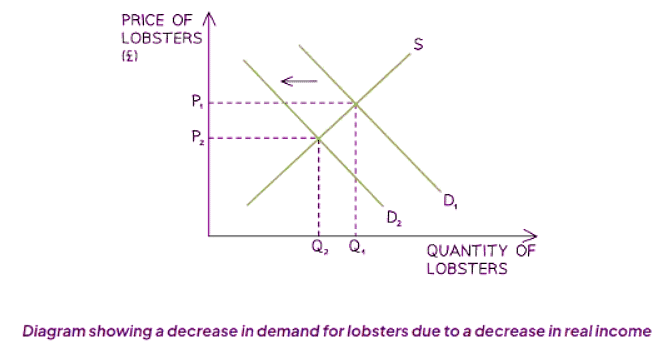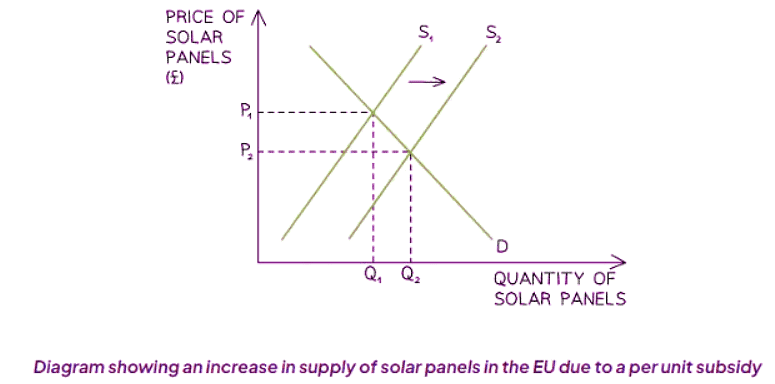Class 10 Exam > Class 10 Notes > Economics for GCSE/IGCSE > Changing Market Conditions
Changing Market Conditions | Economics for GCSE/IGCSE - Class 10 PDF Download
Causes & Consequences of Price Changes
- Real-world markets are in a constant state of flux and are often termed dynamic markets.
- Market equilibrium can undergo rapid changes, fluctuating every few minutes in certain markets (such as stocks and shares) and every few weeks or months in others (like the clothing market).
- Whenever there is a shift in either the demand or supply conditions, a temporary state of disequilibrium arises, leading market forces to rectify the excess demand or supply.
Real World Example: Changes to Demand That Increase Price
- During the lockdowns linked to the Covid-19 pandemic, furniture retailers faced an unexpected surge in demand for their products, particularly desks and sofas.

Diagram Analysis:
- Increased Demand for Desks
- This situation arose due to a surge in demand for desks from D1 to D2.
- Market Imbalance
- Initially, at the price of P1, there is excess demand where the demand surpasses the supply.
- This leads to a scenario of original excess demand in the market.
- Price Adjustment
- Subsequently, suppliers respond by increasing prices, triggering a series of changes.
- This price hike causes a contraction in demand and an extension in supply, culminating in a new market equilibrium at P2 and Q2.
- Both the equilibrium price (P2) and quantity (Q2) rise compared to the previous state, effectively eliminating the excess demand.
- Market Equilibrium Achieved
- The adjustments lead to a state where the market demand equals the supply, clearing the excess demand.
Real World Example: Changes to Supply That Increase Price
Supply Shock and Market Equilibrium
- Following Hurricane Fiona, Puerto Rico faced a supply shock, transitioning from supply level S1 to S2.
- At the original market price (P1), a situation of excess demand emerged, indicating a shortage where demand surpassed supply.
- In response, local sellers raised prices, causing a shift in demand and supply. This resulted in a new market equilibrium at price P2 and quantity Q2.
- The new equilibrium showcased a higher price (P2) and a lower quantity (Q2) compared to pre-hurricane conditions, effectively resolving the initial excess demand.
Real World Example: Changes to Demand That Decrease Price
- In Maine, USA, the demand for lobsters has steadily decreased.
- Result: Prices fell from $12.35/pound on April 1st to $9.35/pound on May 1st.

Diagram Analysis:
- In recent times, the United States has been facing a rise in the inflation rate.
- When inflation occurs, the purchasing power of money diminishes for consumers.
- This reduction in purchasing power effectively leads to a decrease in real income for individuals.
Consequence on Consumption Patterns
- Due to the decreased real income, individuals tend to consume fewer luxury goods.
- As a result of this shift in consumption behavior, the demand for lobsters decreases from D1 to D2.
Market Equilibrium Adjustment
- Initially, at the original market price of P1, there is an oversupply of lobsters in the market.
- Since demand is lower than supply, suppliers start reducing prices gradually to address the excess supply.
- This price reduction leads to a contraction in supply and an extension of demand.
- Eventually, a new market equilibrium is established at price P2 and quantity Q2.
- Both the equilibrium price (P2) and quantity (Q2) are lower than the initial values.
Resolution of Excess Supply
- Through the adjustments in price and quantity, the excess supply of lobsters in the market is eliminated.
Real World Example: Changes to Supply That Decrease Price
- In order to support their climate goals and reduce energy expenses for households, the European Union (EU) is offering subsidies for solar panels.

Diagram Analysis:
- The EU's provision of a subsidy to solar panel retailers leads to an increase in supply from S1 to S2.
- Initially, at the original market price of P1, there is an excess supply or surplus where the supply surpasses the demand.
- Consequently, sellers reduce prices, triggering an extension of demand and a reduction in supply, resulting in a new market equilibrium at P2 and Q2.
- The new equilibrium showcases a lower price (P2) and a higher quantity (Q2) compared to the previous state, effectively clearing the excess supply in the market.
Question for Changing Market ConditionsTry yourself: What happens in a market when there is an increase in demand for a product?View Solution
The document Changing Market Conditions | Economics for GCSE/IGCSE - Class 10 is a part of the Class 10 Course Economics for GCSE/IGCSE.
All you need of Class 10 at this link: Class 10
|
56 videos|97 docs|38 tests
|
FAQs on Changing Market Conditions - Economics for GCSE/IGCSE - Class 10
| 1. How do changing market conditions impact price changes? |  |
Ans. Changing market conditions, such as shifts in supply and demand, can directly affect prices. For example, if there is an increase in demand for a product but the supply remains constant, prices are likely to rise. Conversely, if there is a surplus of supply but low demand, prices may decrease.
| 2. What are some common causes of price changes in a market? |  |
Ans. Price changes in a market can be caused by factors such as changes in production costs, fluctuations in currency exchange rates, government policies and regulations, and shifts in consumer preferences. These factors can all influence the supply and demand dynamics of a market, leading to price changes.
| 3. How do price changes impact consumers and businesses? |  |
Ans. Price changes can have different effects on consumers and businesses. For consumers, price increases can lead to higher costs of living and reduced purchasing power, while price decreases can result in savings and increased buying capacity. For businesses, price changes can impact profit margins, sales volume, and overall competitiveness in the market.
| 4. Can price changes be predicted in advance? |  |
Ans. While it is difficult to predict price changes with certainty, economists and market analysts use various tools and indicators to forecast potential price movements. Factors such as historical data, market trends, and economic indicators are often used to make educated guesses about future price changes.
| 5. How do price changes affect the overall economy? |  |
Ans. Price changes play a crucial role in the overall economy by influencing inflation rates, consumer spending, investment decisions, and overall economic growth. Sudden or drastic price changes can have ripple effects throughout the economy, impacting businesses, households, and government policies.
Related Searches
















